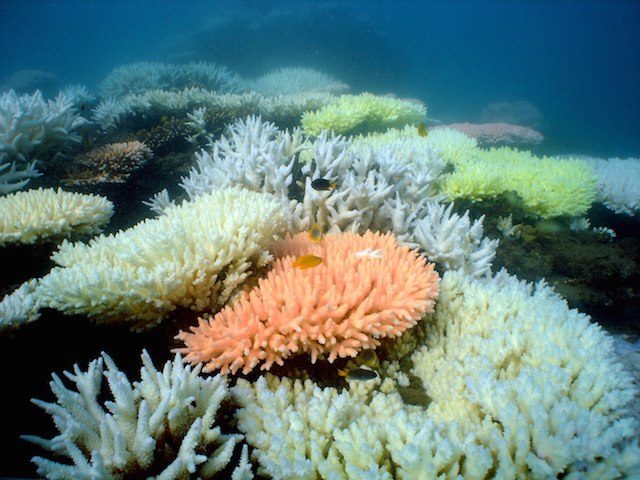SUMMARY
This is AI generated summarization, which may have errors. For context, always refer to the full article.

With the arrival of the El Niño Southern Oscillation (ENSO), and the announcement that global temperatures have risen by 1 degree Celsius, scientists have predicted that 2015 will be the hottest year on record, according to the World Meteorological Organization.
As home to over 600 species of coral, the Coral Triangle and its rich, life-giving reefs are particularly vulnerable to such temperature changes. Corals provide food and shelter for many forms of life, and are essential to the marine ecosystem.
“They are the building blocks of reefs,” says Filipino coral expert Wilfredo “Al” Licuanan of the Capturing Coral Reef & Related Ecosystem Services (CCRES) project, a professor of biology at De La Salle University in the Philippines. “Think of them as foundation or habitat-building species.”
Corals are also the most obvious indicators of any deadly environmental change, particularly as a result of increased seawater temperatures of as much as 2 degrees over the average, over a period of 2 to 4 weeks.
“Coral bleaching is one of the most visual indicators of thermal stress due to climate change,” states the website globalcoralbleaching.org.
“The plants living inside the coral animal’s body, called zooxanthellae, are expelled when the coral is stressed,” explains Licuanan. Corals eliminate these algae because the extreme heat and continuous exposure to sunlight can make them toxic.
“Bleaching also occurs when the pigments inside these algae are degraded. In both cases, the coral’s tissues become transparent, and the white skeleton shows,” Licuanan explains. “In some intermediate stages, the pastel colors of the secondary pigments are revealed – pigments that are important for photosynthesis at different depths, where light is modified by the water.”
The corals first appear to “bloom” with bright colors, before eventually turning white and dying.
Mass bleaching occurs when entire reef systems, and not just individual corals, turn white. The National Oceanic and Atmospheric Administration’s (NOAA) Coral Reef Watch recorded such an event in 1997-1998, which killed 16% of the world’s coral reefs.
In 2010, WWF reported a mass bleaching in the Coral Triangle, where 76% of the Earth’s known coral species can be found. The destruction of reefs was seen in Batangas and Palawan in the Philippines, Tioman and Redang in Malaysia, Aceh and Bali in Indonesia, and other areas.
Third event
This year, NOAA is already predicting a third global bleaching event, which has begun in the United States and Hawaii and is expected to spread globally because of El Niño. “We’re very likely to see the bleaching that’s going on this year go on into 2016, and even be worse in 2016,” said NOAA Coral Reef Watch coordinator C. Mark Eakin in an interview with the New York Times, for the article “The Pacific Ocean becomes a caldron” by John Schwartz.
“One phenomenon appears to be the result of a combination of El Niño, the Blob [a persistent zone of warm water off the coast of North America], and climate change,” wrote Schwartz. “NOAA this year announced that the world was in the midst of only the third global coral bleaching event ever recorded. Severe bleaching can lead to the death of reefs, and the loss of habitat for marine life and shoreline protection from storms.”
Globalcoralbleaching.org estimates that the bleaching will hit 38% of the world’s coral reefs by the end of 2015, killing over 12,000 square kilometers and jeopardizing the livelihoods of 500 million people and over $30 billion in income.

Developing island nations in the Coral Triangle are particularly vulnerable to climate change-related disasters, which impose serious constraints on food security. According to a WWF report, The Coral Triangle and Climate Change: Ecosystems, People and Societies at Risk, without action on climate change, coral reefs in the Coral Triangle will disappear by 2100, the ability of the region’s coastal environments to feed people will decline by 80%, and the livelihoods of around 100 million people will have been lost or severely impacted.
Though some still stick to the notion that temperature rise is a natural phenomenon unrelated to human activity, Licuanan points out, “Corals are more likely to bleach if they are weakened by stressors like sedimentation and pollution.”
There is also ocean acidification, a result of the excessive absorption of carbon dioxide from the atmosphere, and a main cause of bleaching.
“In extreme cases, ocean acidification makes it difficult for corals to build their skeleton, which is made of calcium carbonate, and which, like limestone, can dissolve in acid waters,” says Licuanan.
Not that simple
While corals are also believed to be “durable,” recovering easily from damage under ideal conditions, Licuanan says it is not that simple, and scientists have yet to determine what factors come into play. “We have detailed data showing recovery in reefs in some parts of Taytay Bay, Palawan. Other reefs in the same bay have not recovered since 2010. What allows corals in some places to ‘bounce back,’ and what keeps them from doing so, is only partially understood.”
What WWF has consistently pushed for in the Coral Triangle are long-term conservation strategies than can address many environmental stressors simultaneously. The establishment and proper management of Marine Protected Areas (MPAs) can help prevent coastal and marine pollution, keep fisheries healthy, and control indiscriminate or harmful development in areas of high conservation value, resulting in the building up of an area’s climate resiliency. Through MPAs and accompanying awareness campaigns, areas affected by coral bleaching can also be protected while in the process of recovery.
WWF is using its global experience in policy and advocacy to push for on-the-ground investments in actions that enable people and natural systems to adapt to a changing climate. Reports on a new mass coral bleaching event could only emphasize the importance of the 2015 Paris Climate Conference or Conference of Parties (COP21), to be held from November 30 to December 11 in France, where the leading agenda is an international agreement, involving developing as well as developed countries, to reduce greenhouse gas emissions to keep global warming below 1.5 degrees Celsius. Beyond this temperature, scientists believe the earth’s communities and ecosystems will be unable to survive.
One of WWF’s expected outcomes from Paris is the “protection of the vulnerable,” specifically the protection of forests and ecosystems. WWF proposes that this be supported by an independent loss and damage mechanism to deal with any threats, and adaptation goals that can be universally applied.
While El Niño is expected to persist way into next year, the range of its effects remains hard to predict. It is, however, not too late to act to keep the situation from worsening, Licuanan says.
“There may not be any impacts in some places, while impacts will be worse in others, so it would be difficult to make general statements. What is clear, though, is that we need to reduce the stresses that we impose on reefs. Reducing sedimentation from activities on land such as coastal construction, controlling pollution from garbage and untreated sewage, and addressing unregulated fishing – these will have a tremendous impact.” – Rappler.com
This piece first appeared on www.panda.org on Dec. 1, 2015. Paolo Mangahas leads communications for the WWF Coral Triangle Programme. Follow the WWF Coral Triangle program on or sign up for the monthly newsletter.
Add a comment
How does this make you feel?
There are no comments yet. Add your comment to start the conversation.